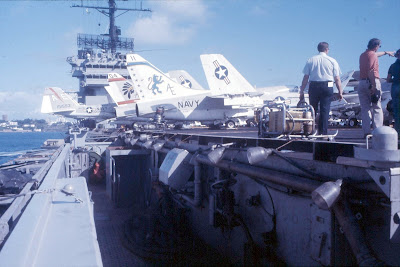
The last owner tried long and hard to raise a fund to restore the Atlantic,this never happened,he had her cut up in disgust and refused offers of parts of her teak decks to be sold on as curios,this was just prior to the recent decades of grand restorations,its such a shame that a man with such vision could not realise his dream but at least I saw her.

A Roy McBride photo taken with a Canon FT 35mm film camera and a 50mm lens,the film was Kodaks Ektachrome Pro slide film.

The remains of the Atlantic,this picture is the property of Roy McBride.
Note there is a sailing vessel sunk in front of the Atlantic,she was then around seventy four years old.

I was recently asked by a blog viewer if I had heard about the launch of a copy of the SV Atlantic,my reply was yes but I also have pictures of the original Atlantic I took myself when she was a wasting hulk and tied up alongside in Portsmouth,Virginia,USA when I was there in 1977.
The ride around the various docks and harbours,with a local resident named Charlie was a total eye opener,across the river in Norfolk,was the imaculate copy
of 'SV America',further along the US Navy had stockpiled all sorts of warships,mothballed for future service need,even the worlds fastest ocean liner,the 'United States' was there,also mothballed as a possible troup carrier,so here we had in view of each other the worlds fasters liner,she still held the Blue Ribbon and before my eyes was all that was left of the worlds fastest sailing ship The Atlantic!
The history:
In 1903, the three masted schooner yacht Atlantic hit 20 knots during her sea trials. In 1905, she became a legend when she crossed the Atlantic, winning the Kaiser’s Cup, sailing 3006 miles in 12 days, 4 hours, 1 minute and 19 seconds. Her record would stand for a full 93 years, the longest standing speed record in the history of yachting.
A brief history of the 3-masted schooner Atlantic
Commissioned by New York Yacht Club member Wilson Marshall, the Atlantic was launched in 1903. William Gardner, one of America's foremost designers of large yachts, designed her. From the moment Atlantic went to sea, it was clear that she was an exceptionally fast and beautiful schooner. When a yacht in 1903 hits twenty knots during her sea trials, she is a promising yacht, but even then nobody could imagine two years later this yacht would set a record that would stand unmatched for almost a century.
Nevertheless, while Wilson Marshall wanted Atlantic to be the fastest schooner on the water, at the same time he felt there was no reason to compromise on comfort. Unlike contemporary racing schooners, Atlantic was equipped with every imaginable luxury. Fitted out with the finest mahogany panelling, she had two steam driven generators powering up the electric lights, refrigerators and a large galley. On deck her halyard winches and primary sheet winches were steam driven too. She had two double and three single staterooms, a lobby, a large full beam saloon, a dining room, a chart & gunroom, three large bathrooms and in the deckhouse there was a comfortable observation room. She had retractable chimneys, so while under sail the below deck steam heating, lighting and refrigerating systems could keep running. Atlantic's fo'c'sle accommodated her thirty-nine strong crew and officers, who would live aboard throughout the year.
During her first season Atlantic proved fast, winning both the Brenton Reef and the Cape May Cup hands down, but it was only in 1905 she made the headlines by winning the Kaiser's Cup, a Transatlantic race from Sandy Hook to the Lizard. Referred to as "The last Great race of Princes" the entries for this race included all the yachts that the rich and powerful from Britain and America could send to sea. The legendary Captain Charlie Barr, who had already successfully defended the America's Cup three times, was hired to skipper Atlantic. Charlie Barr's determination to win was as legendary as his skills for driving the largest of yachts to the very limit. Therefore, he did, sailing 3006 miles in 12 days, 4 hours, 1 minute and 19 seconds. Atlantic's 24-hour record was 341 miles, an average speed of 14,1 knots. Uncountable attempts were made to break this record but it would hold firm until 1998, the longest standing speed record in the history of yachting.
Atlantic's story continued for another seventy-seven years with ownership passing through the likes of Cornelius van der Bilt and Gerald Lambert. She was used as a mother ship for other racing yachts like Vanity, for America's Cup defenders and the J-Class Yankee on her voyage to England. Her guest book included the rich and famous of the world. She was simply the most famous and beloved racing schooner of all time.
Although after World War II Atlantic would never sail again, she refused to give up her existence. Somehow she was saved from the scrap yard on three different occasions, broke loose from her moorings, sailing back to sea without a man aboard and ended up used as a houseboat, a restaurant and a floating dock at a fuel station, until finally on 30th of January 1982, she was broken up at Newport Harbour, Virginia.
The Schooner Atlantic's General Specifications
Design: William Gardner
Year originally built: 1903
Extreme length: 227 feet 69.24 meters
Length over deck: 185 feet 56.43 meters
Waterline length: 135 feet 41.18 meters
Beam: 29 feet 8.85 meters
Draught: 16½ feet 4.90 meters
Displacement: 298 tons 303 tonnes
Sail area to windward: 18,500 feet2 1,720 M2






















